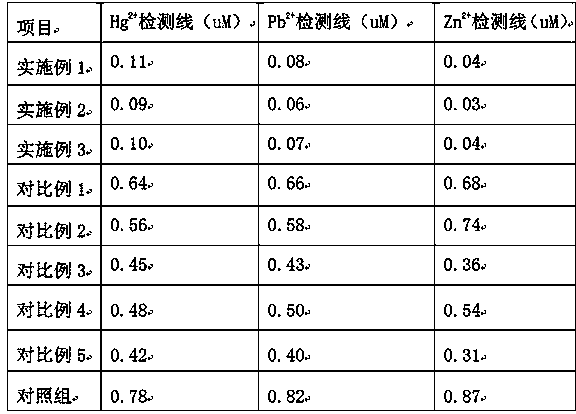Electrode modification material for improving detection performance of biosensor on heavy metal
A biosensor and electrode modification technology, which is applied in the direction of material analysis, material analysis, and material electrochemical variables through electromagnetic means, can solve problems such as pollution control and difficulty in detecting the existence of heavy metal particles, and improve development, utilization, and detection. Fast, fast and sensitive results
- Summary
- Abstract
- Description
- Claims
- Application Information
AI Technical Summary
Problems solved by technology
Method used
Image
Examples
Embodiment 1
[0016] An electrode modification material for improving the detection of heavy metals in a biosensor, the preparation method comprising the following steps:
[0017] (1) Weigh 1.8 grams of yttrium nitrate crystals, add them to a 100-ml beaker, add 30 ml of acetic acid aqueous solution to the beaker, and heat to 90°C in an oil bath, and gradually dissolve the crystals under stirring. After completely dissolving, add 0.33 gram graphene, supersonic treatment 5 minutes, obtain mixture and transfer in the round bottom flask, add 40 milliliters of acetones in the flask, carry out heating reflux reaction after shaking up, reaction temperature is 70 ℃, and the reaction time is 2.5 hours, after the reaction finishes, The obtained reaction product was centrifuged at 4500 rpm for 2 minutes, the supernatant solution was taken, and dried at 140° C. for 70 minutes with a rotary evaporator to obtain a yttrium oxide-graphene oxide composite material;
[0018] (2) Disperse the yttrium oxide-gr...
Embodiment 2
[0024] An electrode modification material for improving the detection of heavy metals in a biosensor, the preparation method comprising the following steps:
[0025] (1) Weigh 1.85 g of yttrium nitrate crystals, add them to a 100 ml beaker, add 33 ml of acetic acid aqueous solution to the beaker, and heat it to 95°C in an oil bath, gradually dissolve the crystals under stirring, and add 0.34 gram of graphene, ultrasonic treatment for 6.5 minutes, the obtained mixture was transferred to a round-bottomed flask, 42 milliliters of acetone was added in the flask, heated and refluxed after shaking up, the reaction temperature was 75°C, and the reaction time was 2.8 hours. After the reaction, The obtained reaction product was centrifuged at 4800 rpm for 2 minutes, the supernatant solution was taken, and dried at 145° C. for 75 minutes with a rotary evaporator to obtain a yttrium oxide-graphene oxide composite material;
[0026] (2) Disperse the yttrium oxide-graphene oxide composit...
Embodiment 3
[0032] An electrode modification material for improving the detection of heavy metals in a biosensor, the preparation method comprising the following steps:
[0033] (1) Weigh 1.9 grams of yttrium nitrate crystals, add them to a 100-ml beaker, add 35 ml of acetic acid aqueous solution to the beaker, and heat it to 100°C in an oil bath, and gradually dissolve the crystals under stirring. After completely dissolving, add 0.35 gram graphene, sonicated for 8 minutes, and the mixture was transferred to a round-bottomed flask, and 45 milliliters of acetone was added in the flask, and after shaking up, reflux reaction was carried out. The reaction temperature was 80° C., and the reaction time was 3.0 hours. After the reaction, The obtained reaction product was centrifuged at 5000 rpm for 3 minutes, the supernatant solution was taken, and dried at 150° C. for 80 minutes with a rotary evaporator to obtain a yttrium oxide-graphene oxide composite material;
[0034](2) Disperse the yttri...
PUM
| Property | Measurement | Unit |
|---|---|---|
| particle size | aaaaa | aaaaa |
| particle diameter | aaaaa | aaaaa |
Abstract
Description
Claims
Application Information
 Login to View More
Login to View More - R&D
- Intellectual Property
- Life Sciences
- Materials
- Tech Scout
- Unparalleled Data Quality
- Higher Quality Content
- 60% Fewer Hallucinations
Browse by: Latest US Patents, China's latest patents, Technical Efficacy Thesaurus, Application Domain, Technology Topic, Popular Technical Reports.
© 2025 PatSnap. All rights reserved.Legal|Privacy policy|Modern Slavery Act Transparency Statement|Sitemap|About US| Contact US: help@patsnap.com

